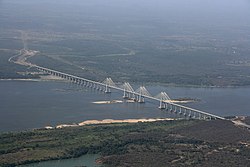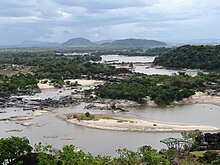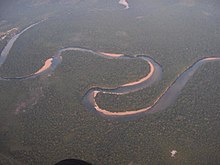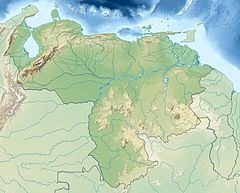Orinoco
| Orinoco River Río Orinoco | |
|---|---|
 Orinoquia Bridge near Ciudad Guayana, Venezuela | |
 The Orinoco drainage basin | |
| Etymology | Warao for "a place to paddle" |
| Location | |
| Countries | |
| Region | South America |
| Physical characteristics | |
| Source | Hydrological source (main stem) |
| • location | Cerro Delgado-Chalbaud, Parima Mountains, Venezuela |
| • coordinates | 2°19′05″N 63°21′42″W / 2.31806°N 63.36167°W |
| • elevation | 1,047 m (3,435 ft) |
| 2nd source | Geographical source (Orinoco-Guaviare-Guayabero-Papamene-Sorrento) |
| • location | Headwaters of Rio Sorrento, Paramo de Sumapaz, Meta, Colombia |
| • coordinates | 3°34′2″N 74°31′23″W / 3.56722°N 74.52306°W (approximately) |
| • elevation | 3,530 m (11,580 ft) (approximately) |
| Mouth | Delta Amacuro |
• location | Atlantic Ocean, Venezuela |
• coordinates | 8°37′N 62°15′W / 8.617°N 62.250°W[1] |
• elevation | 0 m (0 ft) |
| Length | 2,250 km (1,400 mi) |
| Basin size | 989,000 km2 (382,000 sq mi) |
| Depth | |
| • maximum | 100 m (330 ft) |
| Discharge | |
| • location | Orinoco Delta, Atlantic Ocean |
| • average | (Period of data: 1926–2011)37,740 m3/s (1,333,000 cu ft/s)[2] |
| • minimum | 21,000 m3/s (740,000 cu ft/s) |
| • maximum | 54,000 m3/s (1,900,000 cu ft/s) |
| Discharge | |
| • location | Ciudad Bolívar, Venezuela (Basin size: 836,000 km2 (323,000 sq mi)) |
| • average | ( Period: 1926–2011)32,760 m3/s (1,157,000 cu ft/s)[2] |
| Discharge | |
| • location | Puerto Ayacucho, Venezuela ( Basin size: 342,000 km2 (132,000 sq mi)) |
| • average | (Period: 1926–2011)16,182 m3/s (571,500 cu ft/s)[2] |
| Discharge | |
| • location | Masagua, Colombia (Basin size: 101,000 km2 (39,000 sq mi)) |
| • average | 4,400 m3/s (160,000 cu ft/s) |
| Discharge | |
| • location | Tama Tama, Venezuela (Basin size: 37,870 km2 (14,620 sq mi) |
| • average | 1,400 m3/s (49,000 cu ft/s) |
| Basin features | |
| Tributaries | |
| • left | Casiquiare, Atabapo, Guaviare, Vichada, Tomo, Cinaruco, Capanaparo, Meta, Arauca, Apure, Guárico |
| • right | Mavaca, Sipapo, Ocamo, Ventuari, Suapure, Parguaza, Caura, Cuchivero, Aro, Caroní |
The Orinoco (Spanish pronunciation: [oɾiˈnoko]) is one of the longest rivers in South America at 2,250 kilometres (1,400 mi).[citation needed]
Its drainage basin, sometimes known as the Orinoquia,[3] covers 989,000 km2 (382,000 sq mi), with 76% of it in Venezuela and the remainder in Colombia. It is the fourth largest river in the world by discharge volume of water. The Orinoco River and its tributaries are the major transportation system for eastern and interior Venezuela and the Llanos of Colombia. The environment and wildlife in the Orinoco's basin are extremely diverse.
Etymology[edit]
The river's name is derived from the Warao term for "a place to paddle", itself derived from the terms güiri (paddle) and noko (place) i.e. a navigable place.[4][5]
History[edit]
This section needs additional citations for verification. (December 2022) |

The mouth of the Orinoco River at the Atlantic Ocean was documented by Christopher Columbus on 1 August 1498, during his third voyage. Its source at the Cerro Delgado–Chalbaud, in the Parima range, was not explored until 453 years later, in 1951. The source, near the Venezuelan–Brazilian border, at 1,047 metres (3,435 ft) above sea level (2°19′05″N 63°21′42″W / 2.31806°N 63.36167°W), was explored in 1951 by a joint French-Venezuelan expedition.
The Orinoco, as well as its tributaries in the eastern llanos such as the Apure and Meta, were explored in the 16th century by German expeditions under Ambrosius Ehinger and his successors. In 1531, starting at the principal outlet in the delta, the Boca de Navios, Diego de Ordaz sailed up the river to the Meta. Antonio de Berrio sailed down the Casanare to the Meta, and then down the Orinoco River and back to Coro. In 1595, after capturing de Berrio to obtain information while conducting an expedition to find the fabled city of El Dorado, the Englishman Sir Walter Raleigh sailed down the river, reaching the savanna country.
Alexander von Humboldt explored the basin in 1800, reporting on the pink river dolphins. He published extensively on the river's flora and fauna.[6]
The sources of the Orinoco River, located at Cerro Carlos Delgado Chalbaud (2º19’05” N, 63º21’42” W), were discovered in 1951 by the French-Venezuelan expedition that went back and explored the Upper Orinoco course to the Sierra Parima near the border with Brasil, headed by Venezuelan army officer Frank Risquez Iribarren.[7][8]
The first bridge across the Orinoco River, the Angostura Bridge at Ciudad Bolívar, Venezuela, was completed in 1967.[9]
In 1968, an expedition was set off by National Geographic and Hovercraft from Manaus (Brazil) to Port of Spain (Trinidad). Aboard a SR.N6 hovercraft, the expedicionaries followed the Negro river upstream to where it is joined by the Casiquiare canal, on the border between Colombia and Venezuela. After following the Casiquiare to the Orinoco River they hovered thru perilous rapids of the rivers Maipures and Atures. The Orinoco was then traversed down to its mouths in the Gulf of Paria and then to Port of Spain. The primary purpose of the expedition was filming for the BBC series The World About Us episode "The Last Great Journey on Earth from Amazon to Orinoco by Hovercraft", which aired in 1970, and demonstrated the abilities of a hovercraft, thereby promoting sales of this British invention.
The first powerline crossing of the Orinoco River was completed in 1981 for an 800 kV TL single span of 1,200 metres (3,900 ft) using two towers 110 metres (360 ft) tall.[10]
In 1992, an overhead power line crossing for two 400 kV-circuits was completed just west of Morocure (between the cities of Ciudad Bolívar and Ciudad Guayana), north of the confluence of Routes 1 and 19. It had three towers, and the two spans measured 2,161 metres (7,090 ft) and 2,537 metres (8,323 ft), respectively.[10][11][12][13]
In 2006, a second bridge, known as the Orinoquia Bridge, was completed near Ciudad Guayana, Venezuela.[citation needed]
Geography[edit]
The course of the Orinoco forms a wide ellipsoidal arc, surrounding the Guiana Shield; it is divided in four stretches of unequal length that very roughly correspond to the longitudinal zonation of a typical large river:
- Upper Orinoco – 286 kilometres (178 mi) long, from its headwaters to the Raudales de Guaharibos rapids, flows through mountainous landscape in a northwesterly direction
- Middle Orinoco – 805 kilometres (500 mi) long, divided into two sectors, the first of which ca. 515 kilometres (320 mi) long has a general westward direction down to the confluence with the Atabapo and Guaviare rivers at San Fernando de Atabapo; the second flows northward, for about 290 kilometres (180 mi), along the Venezuelan–Colombian border, flanked on both sides by the westernmost granitic upwellings of the Guiana Shield which impede the development of a flood plain, to the Atures rapids near the confluence with the Meta River at Puerto Carreño
- Lower Orinoco – 959 kilometres (596 mi) long with a well-developed alluvial plain, flows in a northeast direction, from Atures rapids down to Piacoa in front of Barrancas
- Delta Amacuro – 200 kilometres (120 mi) long that empties into the Gulf of Paría and the Atlantic Ocean, a very large delta, some 22,500 km2 (8,700 sq mi) and 370 kilometres (230 mi) at its widest.





At its mouth, the Orinoco River forms a wide delta that branches off into hundreds of rivers and waterways that flow through 41,000 km2 (16,000 sq mi) of swampy forests. In the rainy season, the Orinoco River can swell to a breadth of 22 kilometres (14 mi) and a depth of 100 metres (330 ft).
Most of the important Venezuelan rivers are tributaries of the Orinoco River, the largest being the Caroní, which joins it at Puerto Ordaz, close to the Llovizna Falls. A peculiarity of the Orinoco river system is the Casiquiare canal, which starts as an arm of the Orinoco, and finds its way to the Rio Negro, a tributary of the Amazon, thus forming a 'natural canal' between Orinoco and Amazon.
The stream gradient of the entire river is 0.05% (1,047 m over 2,250 km). Downstream of Raudales de Guaharibos the gradient is 0.01% (183[15]/1,964), which is also the gradient from Ciudad Bolivar to the ocean (54/435).
Major rivers in the Orinoco Basin[edit]
- Apure: from Venezuela through the east into the Orinoco
- Arauca: from Colombia to Venezuela east into the Orinoco
- Atabapo: from the Guiana Highlands of Venezuela north into the Orinoco
- Caroní: from the Guiana Highlands of Venezuela north into the Orinoco
- Casiquiare canal: in SE Venezuela, a distributary from the Orinoco flowing west to the Negro River, a major affluent to the Amazon
- Caura: from eastern Venezuela (Guiana Highlands) north into the Orinoco
- Guaviare: from Colombia east into the Orinoco
- Inírida: from Colombia southeast into the Guaviare.
- Meta: from Colombia, border with Venezuela east into the Orinoco
- Ventuari: from eastern Venezuela (the Guiana Highlands) southwest into the Orinoco
- Vichada: from Colombia east into the Orinoco
Ecology[edit]
The boto and the giant otter inhabit the Orinoco River system.[16] The Orinoco crocodile is one of the rarest reptiles in the world. Its range in the wild is restricted to the middle and lower Orinoco River Basin.[17]
More than 1000 fish species have been recorded in the river basin and about 15% are endemic.[18] Among the fish in the river are species found in brackish or salt water in the Orinoco estuary, but also many restricted to fresh water. By far the largest orders are Characiformes and Siluriformes, which together account for more than 80% of the fresh water species.[19] Some of the more famous are the black spot piranha and the cardinal tetra. The latter species, which is important in the aquarium industry, is also found in the Rio Negro, revealing the connection between this river and the Orinoco through the Casiquiare canal.[20] Because the Casiquiare includes both blackwater and clear- to whitewater sections, only relatively adaptable species are able to pass through it between the two river systems.[21]
Economic activity[edit]
The river is navigable for most of its length, and dredging enables ocean ships to go as far as Ciudad Bolívar, at the confluence of the Caroní River, 435 kilometres (270 mi) upstream. River steamers carry cargo as far as Puerto Ayacucho and the Atures Rapids.
El Florero iron mine[edit]
In 1926, a Venezuelan mining inspector found one of the richest iron ore deposits near the Orinoco delta, south of the city of San Felix on a mountain named El Florero. Full-scale mining of the ore deposits began after World War II, by a conglomerate of Venezuelan firms and US steel companies. At the start in the early 1950s, about 10,000 tons of ore-bearing soil was mined per day.[22]
Tar sands[edit]
The Orinoco River deposits also contain extensive tar sands in the Orinoco oil belt, which may be a source of future oil production.[23]
Eastern Venezuelan basin[edit]

Encompassing the states of Anzoategui-Guarico and Monagas states, the Interior Range forms the northern boundary and the Guayana Shield the southern boundary.[24]: 155 Maturin forms the eastern subbasin and Guarico forms the western subbasin.[24]: 156 The El Furrial oil field was discovered in 1978, producing from late Oligocene shallow marine sandstones in an overthrusted foreland basin.[24]: 155
Recreation and sports[edit]
Since 1973, the Civil Association Nuestros Rios son Navegables organize the Internacional Rally Nuestros Rios son Navegables, a motonautical round trip of over 1,200 kilometers through the Orinoco, Meta and Apure Rivers. Starting out from Ciudad Bolívar or San Fernando de Apure, is the longest fluvial rally in the world with the participation of worldwide competitors, more than 30 support boats, logistics teams, thousands of tourists and fans travel. The boats had an average speed of 120 miles per hour.
Since 1988, the local government of Ciudad Guayana has conducted a swim race in the rivers Orinoco and Caroní, with up to 1,000 competitors. Since 1991, the Paso a Nado Internacional de los Rios Orinoco–Caroní has been celebrated every year, on a Sunday close to 19 April. Worldwide, this swim-meet has grown in importance, and it has a large number of competitors.[25] The 26th meet was held in 2016.[26]
In culture[edit]
The Irish singer and songwriter Enya wrote and sang the song "Orinoco Flow", which she released in 1988.[27] Jule Verne's novel Superbe Orénoque has the river as its central theme.
See also[edit]
- Adaheli, the Sun in the mythology of the Orinoco region
- Fishes of the Orinoco in the Wild (2020) book
- "Orinoco Flow" – the song uses the Orinoco and its environs as a theme for its lyrics
Notes[edit]
- ^ Orinoco River at GEOnet Names Server
- ^ a b c José Rafael, Córdova; Marcelo González, Sanabria. "La geografía del agua" (PDF).
- ^ "Orinoquia, Orinoquía". Diccionario panhispánico de dudas. Royal Spanish Academy. 2005. Retrieved 2023-01-07.
- ^ "Orinoco River". Encyclopaedia Britannica. Retrieved 11 April 2020.
- ^ "Orinoco". Diccionario Etimológico Español en Línea. Retrieved 11 April 2020.
- ^ Helferich, Gerard (2004) Humboldt's Cosmos: Alexander von Humboldt and the Latin American Journey that Changed the Way We See the World, Gotham Books, New York; ISBN 1-59240-052-3.
- ^ Alberto Contramaestre Torres. Expedición a las fuentes del Orinoco. Caracas, 1954.
- ^ Pablo J. Anduce. Shailili-Ko. Descubrimiento de las fuentes del Orinoco. Caracas: Talleres Gráficos Ilustraciones S.A., 1960.
- ^ Scott, R. (2001). In the Wake of Tacoma: Suspension Bridges and the Quest for Aerodynamic Stability. American Society of Civil Engineers. p. 184. ISBN 9780784470732. Retrieved 13 April 2015.
- ^ a b "Experience". SAE Power Lines. Archived from the original on 2 August 2015. Retrieved 13 October 2015.
- ^ "Critical Path" (PDF). PEI. June 2005. pp. 105–111, page 107. Archived from the original (PDF) on 23 September 2006.
- ^ "Pylons of the Orinoco High-Voltage Crossing". International Database for Civil and Structural Engineering. Archived from the original on 4 March 2016. Retrieved 13 October 2015.
- ^ "Orinoco Powerline Crossing". Skyscraper Source Media Inc. Archived from the original on 5 March 2016.
- ^ "Ciudad Guayana, Venezuela : Image of the Day". earthobservatory.nasa.gov. 2006-01-23. Retrieved 2009-10-31.
- ^ "Raudal de Guaharibos rapids, Estado Amazonas, Venezuela". ve.geoview.info. Retrieved 2021-07-21.
- ^ WWF: Orinoco River Basin, South America. Retrieved 24 May 2014
- ^ Thorbjarnarson, John B.; Hernández, Gustavo (1993). "Reproductive ecology of the Orinoco crocodile (Crocodylus intermedius) in Venezuela. I. Nesting ecology and egg and clutch relationships". Journal of Herpetology. 27 (4): 363–370. doi:10.2307/1564821. JSTOR 1564821.
- ^ Reis, R. E.; Albert, J. S.; Di Dario, F.; Mincarone, M. M.; Petry, P.; Rocha, L. A. (2016). "Fish biodiversity and conservation in South America". Journal of Fish Biology. 89 (1): 12–47. doi:10.1111/jfb.13016. PMID 27312713.
- ^ Hales, J., and P. Petry: Orinoco Llanos. Orinoco Delta & Coastal Drainages. Retrieved 24 May 2014.
- ^ "Paracheirodon axelrodi, Cardinal Tetra". Seriously Fish. Retrieved 24 May 2014.
- ^ Staeck, W.; Schindler, I. (2015). "Description of a new Heros species (Teleostei, Cichlidae) from the Rio Orinoco drainage and notes on Heros severus Heckel, 1840" (PDF). Bulletin of Fish Biology. 15 (1–2): 121–136. Archived (PDF) from the original on 2022-10-09.[permanent dead link]
- ^ "Venezuela's Magnetic Mountain" Popular Mechanics, July 1949
- ^ Forero, Juan (1 June 2006). "For Venezuela, A Treasure In Oil Sludge". The New York Times. Vol. 155, no. 53597. pp. C1–C6. Archived from the original on 20 December 2016.
- ^ a b c Prieto, R., Valdes, G., 1992, El Furrial Oil Field, In Giant Oil and Gas Fields of the Decade, 1978–1988, AAPG Memoir 54, Halbouty, M.T., editor, Tulsa: American Association of Petroleum Geologists, ISBN 0891813330
- ^ "Antecedentes y Sumario Paso a Nado Internacional de Los Rios Orinoco/Caroni" Paso Nado Internacional de Los Rios Orinoco y Caroní" [Antecedents and Summary of the International Swim Meet of the Orinoco and Caroni Rivers] (in Spanish). Archived from the original on 17 December 2007.
- ^ "26 edición Paso a Nado de Ríos Orinoco y Caroní 2016". Roberto Muñoz Natación Venezuela. Archived from the original on 9 November 2016.
- ^ Moore, Rick (2020-11-18). "Behind the Song: "Orinoco Flow (Sail Away)" by Enya". American Songwriter. Retrieved 2023-12-27.
References[edit]
- Stark, James H. 1897. Stark's Guide-Book and History of Trinidad including Tobago, Granada, and St. Vincent; also a trip up the Orinoco and a description of the great Venezuelan Pitch Lake. Boston, James H. Stark, publisher; London, Sampson Low, Marston & Company. (This book has an excellent description of a trip up the Orinoco as far as Ciudad Bolívar and a detailed description of the Venezuelan Pitch Lake situated on the western side of the Gulf of Paria opposite.)
- MacKee, E.D., Nordin, C.F. and D. Perez-Hernandez (1998). "The Waters and Sediments of the Rio Orinoco and its major Tributaries, Venezuela and Colombia." United States Geological Survey water-supply paper, ISSN 0886-9308 /A-B. Washington: United States Government Printing Office.
- Rawlins, C.B. (1999). The Orinoco River. New York: Franklin Watts.
- Triana, S. Pérez. Down the Orinoco in a Canoe
- Weibezahn, F.H., Haymara, A. and M.W. Lewis (1990). The Orinoco River as an ecosystem. Caracas: Universidad Simon Bolivar.
External links[edit]
- Church, George Earl (1911). . Encyclopædia Britannica. Vol. 20 (11th ed.). pp. 275–276.
- Down the Orinoco in a Canoe at Project Gutenberg (Transcription of book from 1902)
- "Rios de Integracion ". Geurgescu, Paul. CAF. 2017


 French
French Deutsch
Deutsch
